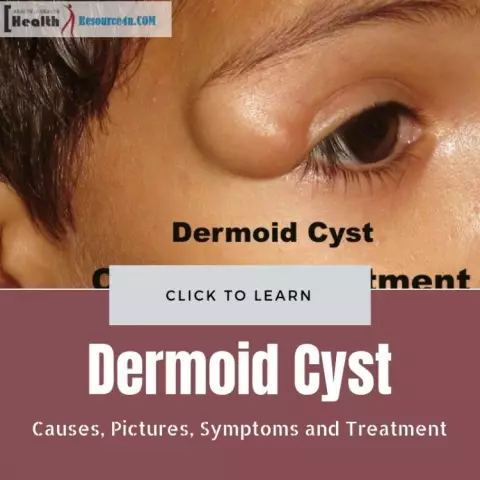- Author Rachel Wainwright [email protected].
- Public 2023-12-15 07:39.
- Last modified 2025-11-02 20:14.
Salivary cyst

A cyst is a pathological cavity in various tissues and organs with a wall and contents.
What is a salivary gland cyst?
A cyst of the salivary gland or a retention cyst of the salivary gland is a cystic formation that is formed due to the difficulty or complete cessation of the outflow of secretion from the gland, impaired patency of the excretory duct of the gland due to its blockage, trauma, plug formed by a thickened secretion. Violation of the patency of the duct of the salivary gland can also be caused by a tumor that has a compressive effect on the duct, or a scar that significantly narrows the canal. At the same time, the cavity is formed by the accumulated secretion, stretching the duct itself or the glandular lobule. The wall of the retention cyst of the salivary gland is lined with a flattened epithelium.
The cyst of the salivary gland can have different localization. Depending on the type of salivary gland affected by cystic formation, there are:
- Retention cyst of the small salivary gland;
- Ranulu (sublingual cyst of a retention nature);
- Cyst of the submandibular salivary gland;
- The cyst of the parotid salivary gland (PCG).
The cyst of the salivary gland is most often formed on the mucous membrane of the lips and cheeks. Regardless of the type of salivary gland affected, cysts in most cases are asymptomatic. Most often, cysts of the small salivary glands are formed, less often cysts of the parotid salivary gland are formed, which is in particular due to the localization of the glands themselves and the likelihood of their mechanical damage.
Small salivary gland cyst: causes, symptoms, diagnosis
A cyst of the small salivary gland is a cystic formation that forms in most cases on the inner surface of the lower lip closer to the corner of the mouth. It can also affect the anterior cheek mucosa. The localization of cysts affecting the small salivary glands is due to an increased risk of mechanical damage to these areas of the oral cavity during eating, talking. The cyst of the small salivary gland is a small, rounded formation, gradually increasing in diameter. In most cases, a cyst of the salivary gland does not bother the patient. In rare cases, patients complain of painful sensations when mechanically acting on the cyst area: when talking, eating, palpation. Usually, cysts affecting the small salivary glands do not deform the oval of the face.
Examination reveals a rounded formation filled with a translucent liquid, reaching 2 cm in diameter. The cyst of the salivary gland protrudes well above the surface of the mucous membrane. The cysts of the salivary gland are clearly limited from the surrounding tissues, have a dense elastic consistency, are mobile, painless. Painful sensations can occur during the inflammatory process. In most cases, a single-chamber cyst is found on the duct of the small salivary gland. In rare cases, a multi-chamber cyst of the salivary gland is diagnosed. Sometimes there is a spontaneous opening of cysts formed on the small salivary gland, in case of violation of the integrity of its shell with arbitrary leakage of the contents into the oral cavity.
When diagnosing a cyst of the small salivary gland, the formation must be differentiated from other tumor neoplasms of the oral cavity in order to choose the correct treatment.
To diagnose a cyst formed on the duct of the small salivary gland, the following methods are used:
- Inspection;
- Puncture.
Parotid cyst: causes, symptoms, diagnosis

The cyst of the parotid salivary gland is a locally limited formation of an elastic, rather dense consistency, painless, forming on the parotid salivary gland duct. This type of cysts of the salivary glands is extremely rare. Cysts that form on the parotid salivary gland are congenital, formed as a result of malformations, as well as retention or acquired, formed under the influence of certain external and internal factors. The reasons for the formation of a cyst of the ALC can become:
- Blockage of the interlobular duct of the gland;
- Its mechanical damage and, as a result, scarring;
- Chronic inflammation of the gland.
The cyst affecting the ducts of the parotid salivary gland is characterized by an elastic consistency and fluctuation. Fluctuation is not determined with a deep location of the cyst of the salivary gland.
With the formation of a cyst of the parotid salivary gland in the lower part, there is a tendency to the spread of its capsule inward, which is due to the anatomical structure of the oral cavity, which also complicates diagnosis and treatment. In rare cases, two parotid glands are affected simultaneously.
The cyst of the parotid salivary gland is also characterized by asymptomatic development. Painful sensations are observed with the formation of an abscess. In complex forms, the formation of a cyst may be accompanied by a limitation of the ability to open the mouth, skin hyperemia.
The ALC cyst requires differential diagnosis to exclude other neoplasms of the parotid salivary gland: lymphadenitis, lipomas, bronchial cysts.
Standard diagnostic methods for cysts affecting the salivary glands are:
- Ultrasound;
- Computed tomography or magnetic resonance imaging in contrast mode;
- Puncture;
- Aspiration biopsy.
Salivary gland cyst: treatment, prevention
When diagnosing a cyst of the salivary gland, treatment involves the surgical removal of the formation. Depending on the localization of the salivary gland cyst, surgical intervention is performed either by intraoral access (cyst of the small salivary gland) or by extraoral (open access). The second technique is used to remove a cyst that forms on the parotid salivary gland. Removal of the cyst of the salivary gland is performed under local anesthesia. At the heart of the prevention of the formation of cysts of the salivary glands is the observance of oral hygiene.
For any form of salivary gland cyst, conservative treatment is not provided.
After removal of various cysts of the salivary gland, sutures are applied to the site of the excised formation. Swelling of the operated area may be observed within 1-3 days.
Salivary cyst removal: risk factors
Removal of the cyst of the salivary gland is a full-fledged surgical intervention, since the manipulation involves the complete separation of the adjacent tissues and the removal of the cyst itself. The main risk when removing the cyst of the salivary gland is the possible connection of the cyst with the branches of the facial nerve, the violation of the integrity of which inevitably entails paralysis of the facial muscles and distortion of the face. Removal of various cysts of the salivary gland, formed on the surface of the lip or cheek, entails lower risks due to the easier access and superficial localization of the cyst. When removing the cyst of the salivary gland, it is important to completely remove its membrane in order to avoid recurrence.
YouTube video related to the article:
The information is generalized and provided for informational purposes only. At the first sign of illness, see your doctor. Self-medication is hazardous to health!






